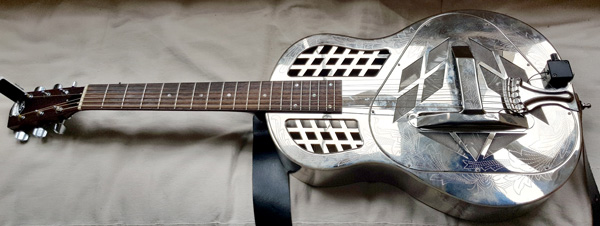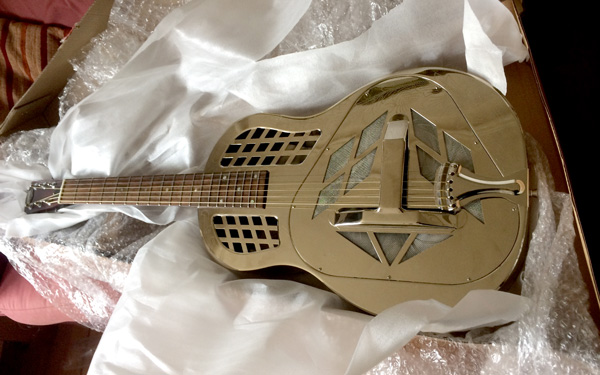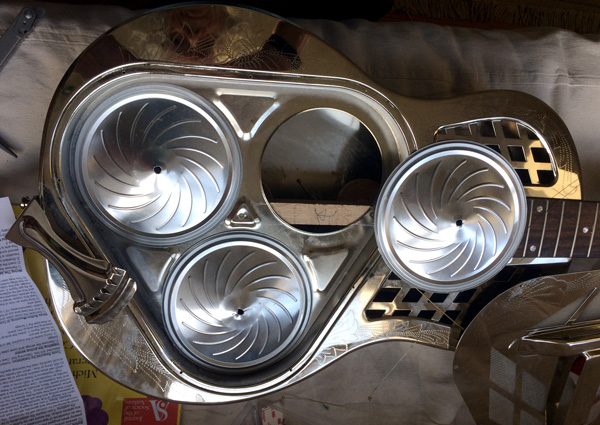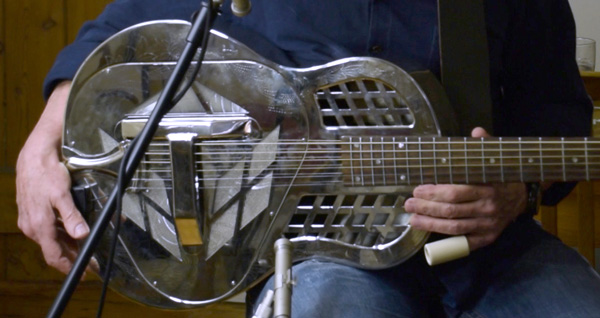
At our last recording session, Jeff our drummer asked me if I’d got a dobro guitar. He thought that it would be perfect for my new song we were recording. Not having played bluegrass or much slide, I had to admit that I didn’t.
Of course, Jeff’s comment played inside my head. So I researched Dobros (which is actually from a brand name) and resonators – guitars made wholly or partially from metal with round metal discs that generate that deeply authentic railroad boxcar sound. Many artists have played them, and once you hear it, you realise that it’s on all sorts of tracks, and not just classic bluegrass and blues: from Dire Straits, through Duane Allman to Johnny Cash. CCR’s Lookin’ Out My Back Door has def got one in there.
A National would be the dream – but not at £2000 – especially when you can’t even play slide (yet)!
I decided a tricone resonator was the answer. They’re said to have a more rounded tone than a single cone – the cones made of spun aluminium, which produces and amplifies the sound. So I found a second-hand Recording King (a fine old Californian company), for not much money.
Enter art deco guitar world! It’s all-metal, shiny, loud and very heavy.

Using a slide it immediately produced that exact slide guitar sound. I could imagine that a combination of slide and normal playing wouldn’t require a drummer or anybody else.
But returning to reality; the action was so high as to be unplayable except with a slide. Plus, I needed to fit a pickup for live gigs. (It’s not that loud…) So as usual when I get a ‘new’ guitar, I took it to pieces.
I found a pick-up from a Canadian company, and in fitting this, decided that the resonator cones looked and sounded a bit tinny. As these are what make the guitar’s sound, I researched replacements – focussing on what people with £3000 Nationals replace their cones with.
New cones made in the UK (thank you Colin Oldham of Delta RC) and not China, arrived two days later and sounded a lot more solid.

You have to be very careful fitting the cones, as they’re extremely fragile until correctly in position. The bridge on which the strings sit to transmit the music vibrations to the body, has three round plastic locator pads which sit in the holes on the top of the cones. The vibrations from the strings onto the bridge resonate through to the cones, which the metal body then amplifies into the sound you hear. But you have to tighten the guitar strings very carefully (from the centre strings outwards) to avoid the cones collapsing under uneven pressure.
My Recording King had sounded great – loud and wonderfully raucous. Whereas now it sounded just as great but with a lot more depth and purity. (I will be very interested to compare it with a National or something a lot more expensive…)
And finally, I worked out that the neck was slightly bowed, so that the strings were much further from the fretboard. This made it impossible to play normally, so I adjusted the truss rod.
Following one of many invaluable tips from my blues master friend Tony Batey, I adjusted the truss rod in small adjustments, then left it overnight to allow the guitar to settle into the new settings. I shall give it another tweak today, but it’s now easily playable, and not far off being the perfect compromise for both slide and normal fretting.
So there is it! A new friend – and my first proper slide acoustic! (Guitar geekery rules.)

And now here’s my first attempts to play some slide, just after guitar reassembly. It’s not any sort of a tune – just jamming around in the key of G!
Traditionally, I should be using and thumb and finger picks. But I reckon it sounds fine with just fingers – and way plenty loud enough – so I’m not going to bother with another unfamiliar complication.
